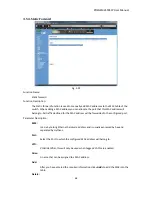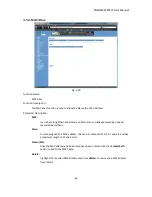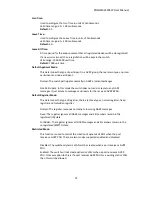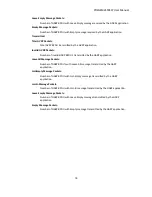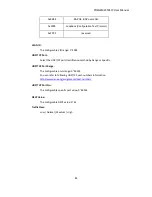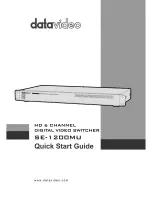
POEGEM24T4SFP
User
Manual
74
Join
Time:
Used
to
configure
the
Join
Time
in
units
of
Centiseconds.
Valid
time
range:
20
–
100
centiseconds
Default:
20
Leave
Time:
Used
to
configure
the
Leave
Time
in
units
of
Centiseconds.
Valid
time
range:
60
–
300
centiseconds
Default:
60
Leave
All
Time:
A
time
period
for
the
announcement
that
all
registered
devices
will
be
de
‐
registered.
If
a
new
join
is
issued,
then
a
registration
will
be
kept
in
the
switch.
Valid
range:
1000
‐
5000
unit
time.
Default:
1000
unit
time.
Default
Applicant
Mode:
This
determines
the
type
of
participant
in
a
GVRP
group,
there
are
two
types,
normal
participant
and
non
‐
participant.
Normal:
The
switch
participates
normally
in
GARP
protocol
exchanges.
Non
Participant:
In
this
mode
the
switch
does
not
send
or
reply
to
any
GARP
messages.
It
just
listens
to
messages
and
reacts
for
the
received
GVRP
BPDU.
Default
Registrar
Mode:
This
determines
the
type
of
registrar,
there
are
three
types,
normal
registrar,
fixed
registrar
and
forbidden
registrar.
Normal:
The
registrar
responds
normally
to
incoming
GARP
messages.
Fixed:
The
registrar
ignores
all
GARP
messages
and
all
members
remain
in
the
registered
(IN)
state.
Forbidden:
The
registrar
ignores
all
GARP
messages
and
all
members
remain
in
the
unregistered
(EMPTY)
state.
Restricted
Mode:
This
function
is
used
to
restrict
the
creation
of
dynamic
VLAN’s
when
the
port
receives
a
GVRP
PDU.
There
are
two
modes
supported
enabled
and
disabled.
Disabled:
The
switches
dynamic
VLAN
will
be
created
when
a
port
receives
a
GVRP
PDU.
Enabled:
The
switch
will
not
create
dynamic
VLAN’s
when
a
port
receives
a
GVRP
PDU.
Once
exception
to
this
is
if
a
port
receives
GVRP
PDU
for
a
existing
static
VLAN,
then
this
will
be
allowed.
Summary of Contents for POEGEM24T4SFP
Page 68: ...POEGEM24T4SFP User Manual 68 Move to the previous page Next Page Move to the next page...
Page 82: ...POEGEM24T4SFP User Manual 82 Fig 3 42 Fig 3 43 Fig 3 44...
Page 89: ...POEGEM24T4SFP User Manual 89 Fig 3 48...
Page 106: ...POEGEM24T4SFP User Manual 106 Fig 3 71 Fig 3 72...
Page 108: ...POEGEM24T4SFP User Manual 108 Fig 3 75 Fig 3 76 Fig 3 77 ARP...
Page 109: ...POEGEM24T4SFP User Manual 109 Fig 3 78 ARP Fig 3 79 ARP Fig 3 80 ARP Fig 3 81 ARP...
Page 110: ...POEGEM24T4SFP User Manual 110 Fig 3 82 ARP Fig 3 83 ARP Fig 3 84 ARP Fig 3 85 ARP...
Page 111: ...POEGEM24T4SFP User Manual 111 Fig 3 86 ARP Fig 3 87 ARP Fig 3 88 ARP Fig 3 89 ARP Fig 3 90 ARP...
Page 112: ...POEGEM24T4SFP User Manual 112 Fig 3 91 IPv4 Fig 3 92 IPv4 Fig 3 93 IPv4...
Page 115: ...POEGEM24T4SFP User Manual 115 Fig 3 105 IPv4 Fig 3 106 IPv4 Fig 3 107 IPv4...
Page 116: ...POEGEM24T4SFP User Manual 116 Fig 3 108 IPv4 Fig 3 109 IPv4 Fig 3 110 IPv4...
Page 117: ...POEGEM24T4SFP User Manual 117 Fig 3 111 IPv4 Fig 3 112 IPv4 Fig 3 113 IPv4 Fig 3 114 IPv4...
Page 118: ...POEGEM24T4SFP User Manual 118 Fig 3 115 IPv4 Fig 3 116 IPv4 Fig 3 117 IPv4...
Page 119: ...POEGEM24T4SFP User Manual 119 Fig 3 118 IPv4 Fig 3 119 IPv4 Fig 3 120 IPv4...
Page 120: ...POEGEM24T4SFP User Manual 120 Fig 3 121 Action Fig 3 122 Rate Limiter...
Page 121: ...POEGEM24T4SFP User Manual 121 Fig 3 123 Port Copy Fig 3 124 DMAC Filter...
Page 211: ...POEGEM24T4SFP User Manual 211 Fig 4 3...
Page 238: ...POEGEM24T4SFP User Manual 238 2 1 3 1 4 1 5 1 POEGEM24T4SFP acl...





